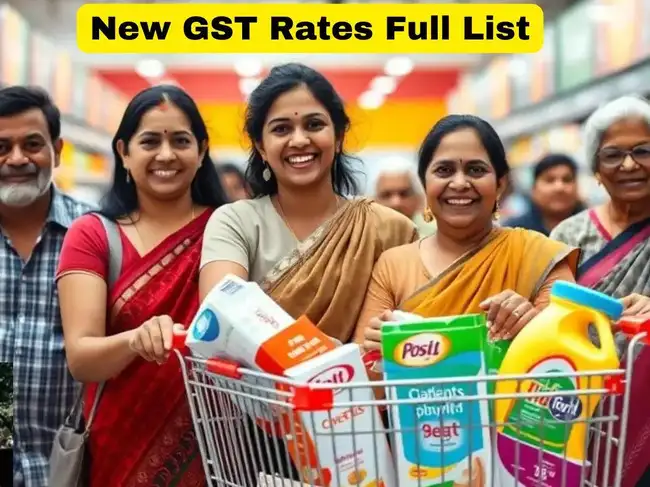GST Rate Changes 2025: Full List of Revised Rates Effective from Navratri, September 22
Check the full list of GST rate changes effective September 22, 2025. New slabs, revised tax rates, and items getting cheaper this Navratri.

GST Rate Changes 2025: What You Need to Know
From September 22, 2025 — the first day of Navratri — India’s Goods and Services Tax (GST) regime is getting a major overhaul. The GST Council has approved sweeping rate rationalisation, with a simpler tax structure and much-needed relief for the consumer. Press Information BureauThe Indian ExpressThe Economic Times
1. What’s changing?
-
The GST slabs are being rationalised from four tiers (5%, 12%, 18%, 28%) to a simpler structure:
-
5% for essential goods and daily-use items,
-
18% for standard goods and services,
-
and a new 40% “luxury/sin goods” rate for high-end products and tobacco‐related items. Business OutreachThe Indian ExpressPress Information BureauKotak Mutual FundIndia Briefing
-
-
Most goods and services will move into the 5% or 18% slabs. The Economic TimesPress Information BureauIndia Briefing
-
Tobacco, gutkha, cigarettes and related products are exempt from the change for now — they will continue under the existing GST and compensation cess until further notice. Press Information BureauJagranjosh.comIndia Briefing
The idea is to reduce the tax burden on essentials, spur consumption ahead of the festive season, reduce disputes and blocked credit, and simplify compliance. Press Information BureauThe Economic TimesCAclubindiaIndia Briefing
2. Key items getting GST cuts
Here are some of the headline changes to look out for:
| Category | Old GST rate(s) | New GST rate |
|---|---|---|
| UHT milk | 5% | Nil |
| Pre-packaged & labelled chhena/paneer | 5% | Nil |
| Condensed milk | 12% | 5% |
| Butter, ghee, dairy spreads | 12% | 5% |
| Hair oil, shampoo, soap bars, toothpaste, toothbrushes | 18% | 5% |
| Packaged snacks / namkeens | 12% | 5% |
| Tractor tyres and parts, tractors | 18%/12% | 5% |
| Televisions >32″, small cars, cement | 28% | 18% |
| Medical kits and diagnostic apparatus (thermometers, glucometers, reagents) | 12% | 5% |
| Education-related items (maps, globes, pencils, erasers, notebooks) | 5% or 12% | Nil or exempt |
| Life and health insurance | 18% | Nil |
(This is a representative list; full details are available in the GST Council notification and detailed annexures.)
3. What this means for consumers and businesses
-
Cheaper essentials: Daily-use products, food processing items and healthcare goods are going to cost less. That’s a real boost for the average household, especially as we move into the festive season. Press Information BureauKotak Mutual FundNews on AirThe Economic Times
-
More consumption, more growth: Lower taxes on FMCG, food, telecom, automobiles and appliances could stimulate higher spending. The government expects this to fuel economic activity and might even act as a fiscal stimulus. The Economic TimesKotak Mutual FundIndia BriefingBusiness Outreach
-
Less complexity, fewer disputes: With fewer GST slabs and more rationalised rates, businesses may face fewer classification disagreements and less blocked input tax credit. Press Information BureauCAclubindiaIndia BriefingPress Information Bureau
-
Festive-season benefit: The timing is very deliberate — coming into effect exactly on Navratri, this GST reform serves as a kind of “early Diwali gift” to consumers and businesses alike. Business OutreachThe Economic Times+1The Times of India
4. A few caveats
-
Not everything is getting cheaper. Products labelled as “luxury” or “sin goods” will face a new 40% GST rate, and tobacco products and compensation cess provisions still apply. Business OutreachPress Information BureauWorld Trade ScannerJagranjosh.comIndia Briefing
-
Businesses must update their billing systems and inventory tagging by September 22, and communicate changes to customers. Delays or misclassification could lead to compliance issues. CAclubindiaIndia BriefingPress Information Bureau
-
Watch out for price-adjustment behavior. Some retailers might not pass along the full tax benefit immediately, or might adjust non-taxed margins. It will be worth monitoring actual on-shelf prices.
5. What you can do
-
If you're a consumer:
-
Look to buy essentials, FMCG goods, packaged foods, small appliances, basic automobile products and farm equipment post-September 22 — you may find better deals due to lower GST.
-
Keep receipts and check bills to see whether the GST drop is being passed on.
-
Plan big purchases (especially small cars, TVs or tractors) to leverage lower tax rates.
-
-
If you're a business owner or retailer:
-
Update your billing, ERP or accounting software for the new GST rates well ahead of Navratri.
-
Re-train staff, particularly in sales and billing, to apply the correct new rates.
-
Communicate to customers that prices may drop (or at least that tax burdens are lower) — good PR during the festive buying season.
-
Revisit product pricing and input tax credit flow, especially for FMCG, food processing, farm machinery, healthcare supplies and education items.
-
6. Conclusion
The GST reform package coming into effect from September 22, 2025 is one of the most substantial tax rationalisations in India since the introduction of GST itself. By simplifying slabs, reducing rates on essentials and daily-use goods, and providing relief to healthcare, educational items and farm inputs, the reform aims to ease life for consumers while boosting demand and cutting red tape for businesses.
If you’re planning purchases, stocking inventory, or advising customers this festive season, these GST changes could make a meaningful difference — and a timely one.
What's Your Reaction?
 Like
0
Like
0
 Dislike
0
Dislike
0
 Love
0
Love
0
 Funny
0
Funny
0
 Angry
0
Angry
0
 Sad
0
Sad
0
 Wow
0
Wow
0





































































